A Hybrid Modeling Approach for Estimating the Exposure to Organophosphate Pesticide Drift in Sangamon County, Illinois
Abstract
:1. Introduction
- How many residential areas and water bodies in Sangamon County are at risk of being exposed to organophosphate pesticides?
- Where the areas with the highest percentage of pesticide are drift exposure incidents in Sangamon County?
2. Materials and Methods
2.1. Study Area
2.2. Datasets
2.2.1. HYSPLIT Meteorological Input Data
2.2.2. Crop Data
2.2.3. Pesticide Usage Data
2.2.4. Land Use/Land Cover Dataset
2.2.5. Meteorological Data
2.3. Methodology
2.3.1. HYSPLIT Clustering Analysis
2.3.2. Potential Source Contribution Function (PSCF)
2.3.3. Backward Dispersion Analysis
2.3.4. AgDRIFT Model
2.3.5. Study’s Hypotheses and Limitations
3. Result and Discussion
3.1. HYSPLIT Clustering Analysis and Trajectory Calculation
3.2. The Potential Source Contribution Function (PSCF)
3.3. Backward Dispersion Analysis
3.4. AgDRIFT Model for Field-Level Simulations
4. Conclusions
Author Contributions
Funding
Data Availability Statement
Conflicts of Interest
References
- Sharma, A.; Kumar, V.; Shahzad, B.; Tanveer, M.; Sidhu, G.P.S.; Handa, N.; Kohli, S.K.; Yadav, P.; Bali, A.S.; Parihar, R.D.; et al. Worldwide pesticide usage and its impacts on ecosystem. SN Appl. Sci. 2019, 1, 1446. [Google Scholar] [CrossRef]
- Bhatt, P.; Zhou, X.; Huang, Y.; Zhang, W.; Chen, S. Characterization of the role of esterases in the biodegradation of organophosphate, carbamate, and pyrethroid pesticides. J. Hazard. Mater. 2021, 411, 125026. [Google Scholar] [CrossRef] [PubMed]
- Bhatt, P.; Bhatt, K.; Sharma, A.; Zhang, W.; Mishra, S.; Chen, S. Biotechnological basis of microbial consortia for the removal of pesticides from the environment. Crit. Rev. Biotechnol. 2021, 41, 317–338. [Google Scholar] [CrossRef] [PubMed]
- Pathak, V.M.; Verma, V.K.; Rawat, B.S.; Kaur, B.; Babu, N.; Sharma, A.; Dewali, S.; Yadav, M.; Kumari, R.; Singh, S.; et al. Current status of pesticide effects on environment, human health and it’s eco-friendly management as bioremediation: A comprehensive review. Front. Microbiol. 2022, 13, 962619. [Google Scholar] [CrossRef] [PubMed]
- Burchfield, S.L.; Bailey, D.C.; Todt, C.E.; Denney, R.D.; Negga, R.; Fitsanakis, V.A. Acute exposure to a glyphosate-containing herbicide formulation inhibits Complex II and increases hydrogen peroxide in the model organism Caenorhabditis elegans. Environ. Toxicol. Pharmacol. 2018, 66, 36–42. [Google Scholar] [CrossRef]
- Centner, T.J.; Russell, L.; Mays, M. Viewing evidence of harm accompanying uses of glyphosate-based herbicides under US legal requirements. Sci. Total Environ. 2018, 648, 609–617. [Google Scholar] [CrossRef]
- Chen, M.; Chang, C.-H.; Tao, L.; Lu, C. Residential Exposure to Pesticide During Childhood and Childhood Cancers: A Meta-Analysis. Pediatrics 2015, 136, 719–729. [Google Scholar] [CrossRef] [PubMed]
- Boffetta, P.; Adami, H.-O.; Berry, S.C.; Mandel, J.S. Atrazine and Cancer: A Review of the Epidemiologic Evidence. Eur. J. Cancer Prev. 2013, 22, 169–180. [Google Scholar] [CrossRef]
- VoPham, T.; Brooks, M.M.; Yuan, J.-M.; Talbott, E.O.; Ruddell, D.; Hart, J.E.; Chang, C.-C.H.; Weissfeld, J.L. Pesticide exposure and hepatocellular carcinoma risk: A case-control study using a geographic information system (GIS) to link SEER-Medicare and California pesticide data. Environ. Res. 2015, 143, 68–82. [Google Scholar] [CrossRef]
- Worldatlas. 2022. Available online: https://www.worldatlas.com/articles/toppesticide-consuming-countries-of-the-world.html (accessed on 14 December 2023).
- The WHO Recommended Classification of Pesticides by Hazard and Guidelines to Classification: 2009; World Health Organization: Geneva, Switzerland, 2010.
- Thundiyil, J.G.; Stober, J.; Besbelli, N.; Pronczuk, J. Acute pesticide poisoning: A proposed classification tool. Bull. World Health Organ. 2008, 86, 205–209. [Google Scholar] [CrossRef]
- Worldometer Pesticide Use by Country. Available online: https://www.worldometers.info/food-agriculture/pesticides-by-country/ (accessed on 7 July 2022).
- International Union of Pure and Applied Chemistry (IUPAC). Global Availability of Information on Agrochemicals. Available online: http://sitem.herts.ac.uk/aeru/iupac/atoz.htm (accessed on 1 August 2023).
- U.S. EPA. Regulatory Impact Analysis of Worker Protection Standard for Agricultural Pesticides; Report Number EPA/735/R/92/002; Biological and Economic Analysis Division Office of Pesticide Programs: Washington, DC, USA, 1992; Volume 20460. Available online: https://nepis.epa.gov/Exe/ZyPDF.cgi?Dockey=P100LYPD.PDF (accessed on 20 September 2023).
- Donley, N.; Bullard, R.D.; Economos, J.; Figueroa, I.; Lee, J.; Liebman, A.K.; Martinez, D.N.; Shafiei, F. Pesticides and environmental injustice in the USA: Root causes, current regulatory reinforcement and a path forward. BMC Public Health 2022, 22, 708. [Google Scholar] [CrossRef] [PubMed]
- Karunarathne, A.; Gunnell, D.; Konradsen, F.; Eddleston, M. How many premature deaths from pesticide suicide have occurred since the agricultural Green Revolution? Clin. Toxicol. 2020, 58, 227–232. [Google Scholar] [CrossRef] [PubMed]
- Faluomi, M.; Cialini, M.; Naviganti, M.; Mastromauro, A.; Marinangeli, F.; Angeletti, C. Organophosphates pesticide poisoning: A peculiar case report. J. Emerg. Crit. Care Med. 2022, 6, 30. [Google Scholar] [CrossRef]
- Alavanja, M.C.R. Introduction: Pesticides Use and Exposure, Extensive Worldwide. Rev. Environ. Health 2009, 24, 303–310. [Google Scholar] [CrossRef]
- Alavanja, M.C.R.; Sprince, N.L.; Oliver, E.; Whitten, P.; Lynch, C.F.; Gillette, P.P.; Logsden-Sacket, N.; Zwerling, C. Nested case-control analysis of high pesticide exposure events from the Agricultural Health Study. Am. J. Ind. Med. 2001, 39, 557–563. [Google Scholar] [CrossRef] [PubMed]
- Brouwer, M.; Kromhout, H.; Vermeulen, R.; Duyzer, J.; Kramer, H.; Hazeu, G.; De Snoo, G.; Huss, A. Assessment of residential environmental exposure to pesticides from agricultural fields in the Netherlands. J. Expo. Sci. Environ. Epidemiol. 2017, 28, 173–181. [Google Scholar] [CrossRef] [PubMed]
- Parrón, T.; Requena, M.; Hernández, A.F.; Alarcón, R. Environmental exposure to pesticides and cancer risk in multiple human organ systems. Toxicol. Lett. 2014, 230, 157–165. [Google Scholar] [CrossRef] [PubMed]
- Yan, D.; Zhang, Y.; Liu, L.; Yan, H. Pesticide exposure and risk of Alzheimer’s disease: A systematic review and meta-analysis. Sci. Rep. 2016, 6, 32222. [Google Scholar] [CrossRef]
- Zhang, C.; Hu, R.; Huang, J.; Huang, X.; Shi, G.; Li, Y.; Yin, Y.; Chen, Z. Health effect of agricultural pesticide use in China: Implications for the development of GM crops. Sci. Rep. 2016, 6, 34918. [Google Scholar] [CrossRef]
- King, A.M.; Aaron, C.K. Organophosphate and Carbamate Poisoning. Emerg. Med. Clin. N. Am. 2015, 33, 133–151. [Google Scholar] [CrossRef]
- Sinha, S.N.; Kumar, K.R.; Ungarala, R.; Kumar, D.; Deshpande, A.; Vasudev, K.; Boiroju, N.K.; Singh, A.; Naik, R.P.; Pokharakar, S. Toxicokinetic analysis of commonly used pesticides using data on acute poisoning cases from Hyderabad, South India. Chemosphere 2020, 268, 129488. [Google Scholar] [CrossRef] [PubMed]
- Alkon, A.; Gunier, R.B.; Hazard, K.; Castorina, R.; Hoffman, P.D.; Scott, R.P.; Anderson, K.A.; Bradman, A. Preschool-Age Children’s Pesticide Exposures in Childcare Centers and at Home in Northern California. J. Pediatr. Health Care 2022, 36, 34–45. [Google Scholar] [CrossRef] [PubMed]
- Lu, C.; Fenske, R.A.; Simcox, N.J.; Kalman, D. Pesticide Exposure of Children in an Agricultural Community: Evidence of Household Proximity to Farmland and Take Home Exposure Pathways. Environ. Res. 2000, 84, 290–302. [Google Scholar] [CrossRef] [PubMed]
- Yusà, V.; Coscollà, C.; Mellouki, W.; Pastor, A.; de la Guardia, M. Sampling and analysis of pesticides in ambient air. J. Chromatogr. A 2009, 1216, 2972–2983. [Google Scholar] [CrossRef] [PubMed]
- Manley, C.K.; Villanger, G.D.; Thomsen, C.; Cequier, E.; Sakhi, A.K.; Reichborn-Kjennerud, T.; Herring, A.H.; Øvergaard, K.R.; Zeiner, P.; Roell, K.R.; et al. Prenatal Exposure to Organophosphorus Pesticides and Preschool ADHD in the Norwegian Mother, Father and Child Cohort Study. Int. J. Environ. Res. Public Health 2022, 19, 8148. [Google Scholar] [CrossRef] [PubMed]
- Tessari, L.; Angriman, M.; Díaz-Román, A.; Zhang, J.; Conca, A.; Cortese, S. Association Between Exposure to Pesticides and ADHD or Autism Spectrum Disorder: A Systematic Review of the Literature. J. Atten. Disord. 2020, 26, 48–71. [Google Scholar] [CrossRef] [PubMed]
- El Afandi, G.; Ismael, H.; Fall, S.; Ankumah, R. Effectiveness of Utilizing Remote Sensing and GIS Techniques to Estimate the Exposure to Agricultural Pesticides Drift over Macon, Alabama. Agronomy 2023, 13, 1759. [Google Scholar] [CrossRef]
- Boonupara, T.; Udomkun, P.; Khan, E.; Kajitvichyanukul, P. Airborne Pesticides from Agricultural Practices: A Critical Review of Pathways, Influencing Factors, and Human Health Implications. Toxics 2023, 11, 858. [Google Scholar] [CrossRef]
- Tudi, M.; Ruan, H.D.; Wang, L.; Lyu, J.; Sadler, R.; Connell, D.; Chu, C.; Phung, D.T. Agriculture Development, Pesticide Application and Its Impact on the Environment. Int. J. Environ. Res. Public Health 2021, 18, 1112. [Google Scholar] [CrossRef]
- Menezes, A.; Neves, F.; Afonso, P.; Pereira, D.P. Development, validation, and application of a method based on DI-SPME and GC–MS for determination of pesticides of different chemical groups in surface and groundwater samples. Microchem. J. 2010, 96, 139–145. [Google Scholar]
- Carles, C.; Bouvier, G.; Lebailly, P.; Baldi, I. Use of job-exposure matrices to estimate occupational exposure to pesticides: A review. J. Expo. Sci. Environ. Epidemiol. 2016, 27, 125–140. [Google Scholar] [CrossRef] [PubMed]
- Schulz, R.; Bub, S.; Petschick, L.L.; Stehle, S.; Wolfram, J. Applied pesticide toxicity shifts toward plants and invertebrates, even in GM crops. Science 2021, 372, 81–84. [Google Scholar] [CrossRef] [PubMed]
- Wang, Z.; He, X.; Li, T.; Huang, M.; Zhang, Y.; Xu, L.; Deng, X. Evaluation method of pesticide droplet drift based on laser imaging. Trans. Chin. Soc. Agric. Eng. 2019, 35, 73–79. [Google Scholar]
- Gil, E.; Llorens, J.; Llop, J.; Fàbregas, X.; Gallart, M. Use of a Terrestrial LIDAR Sensor for Drift Detection in Vineyard Spraying. Sensors 2013, 13, 516–534. [Google Scholar] [CrossRef] [PubMed]
- Teske, M.E.; Bird, S.L.; Esterly, D.M.; Curbishley, T.B.; Ray, S.L.; Perry, S.G. AgDrift®: A model for estimating near-field spray drift from aerial applications. Environ. Toxicol. Chem. 2002, 21, 659–671. [Google Scholar] [PubMed]
- Yuan, S.; Arellano, A.F.; Knickrehm, L.; Chang, H.I.; Castro, C.L.; Furlong, M. Towards quanti-fying atmospheric dispersion of pesticide spray drift in Yuma County Arizona. Atmos. Environ. 2024, 319, 120262. [Google Scholar] [CrossRef] [PubMed]
- Pivato, A.; Barausse, A.; Zecchinato, F.; Palmeri, L.; Raga, R.; Lavagnolo, M.C.; Cossu, R. An integrated model-based approach to the risk assessment of pesticide drift from vineyards. Atmos. Environ. 2015, 111, 136–150. [Google Scholar] [CrossRef]
- El Afandi, G.; Ismael, H.; Fall, S. Application of OpenAir and AgDRIFT Models to Estimate Organophosphate Pesticide Spray Drift: A Case Study in Macon County, Alabama. Agriculture 2023, 13, 1763. [Google Scholar] [CrossRef]
- Wieben, C.M. Estimated Annual Agricultural Pesticide Use by Major Crop or Crop Group for States of the Conterminous United States, 1992–2019 (Including Preliminary Estimates for 2018–2019); U.S. Geological Survey Data Release; U.S. Geological Survey: Reston, VA, USA, 2021.
- Illinois Department Agriculture. 2023. Available online: https://agr.illinois.gov/pesticides/pesticides-uses-misuses.html#:~:text=If%20you%20believe%20your%20property,the%20damage%20was%20first%20noticed (accessed on 21 December 2023).
- Wan, N. Pesticides exposure modeling based on GIS and remote sensing land use data. Appl. Geogr. 2015, 56, 99–106. [Google Scholar] [CrossRef]
- Lerro, C.C.; Koutros, S.; Andreotti, G.; Friesen, M.C.; Alavanja, M.C.; Blair, A.; A Hoppin, J.; Sandler, D.P.; Lubin, J.H.; Ma, X.; et al. Organophosphate insecticide use and cancer incidence among spouses of pesticide applicators in the Agricultural Health Study. Occup. Environ. Med. 2015, 72, 736–744. [Google Scholar] [CrossRef]
- Wang, M.; Rautmann, D. A simple probabilistic estimation of spray drift—Factors determining spray drift and development of a model. Environ. Toxicol. Chem. 2008, 27, 2617–2626. [Google Scholar] [CrossRef] [PubMed]
- Larsen, K.; Black, P.; Rydz, E.; Nicol, A.-M.; Peters, C.E. Using geographic information systems to estimate potential pesticide exposure at the population level in Canada. Environ. Res. 2020, 191, 110100. [Google Scholar] [CrossRef] [PubMed]
- Ward, H.; Nuckols, R.; Weigel, J.; Maxwell, S.; Cantor, P.; Miller, S. Identifying populations potentially exposed to agricultural pesticides using remote sensing and a geographic information system. Environ. Health Perspect. 2000, 108, 5–12. [Google Scholar] [PubMed]
- Brody, J.; Vorhees, D.; Melly, J.; Swedis, R.; Drivas, P.; Rudel, R. Using GIS and historical records to reconstruct residential exposure to large-scale pesticide application. J. Expo. Anal. Environ. Epidemiol. 2002, 12, 64–80. [Google Scholar] [CrossRef] [PubMed]
- Brody, J.; Aschengrau, A.; McKelvey, W.; Rudel, R.; Swartz, C.; Kennedy, T. Breast cancer risk and historical exposure to pes-ticide from wide-area applications assessed with GIS. Environ. Health Perspect. 2004, 112, 889–897. [Google Scholar] [CrossRef] [PubMed]
- Maxwell, S.; Jaymie, R.; Pierre, G. Use of Land Surface Remotely Sensed Satellite and Airborne Data for Environmental Ex-posure Assessment in Cancer Research. J. Expo. Sci. Environ. Epidemiol. 2010, 20, 176. [Google Scholar] [CrossRef] [PubMed]
- Marusek, J.C.; Cockburn, M.G.; Mills, P.K.; Ritz, B.R. Control Selection and Pesticide Exposure Assessment Via GIS in Prostate Cancer Studies. Am. J. Prev. Med. 2006, 30, S109–S116. [Google Scholar] [CrossRef] [PubMed]
- Nuckols, J.R.; Gunier, R.B.; Riggs, P.; Miller, R.; Reynolds, P.; Ward, M.H. Linkage of the California Pesticide Use Reporting Database with Spatial Land Use Data for Exposure Assessment. Environ. Health Perspect. 2007, 115, 684–689. [Google Scholar] [CrossRef] [PubMed]
- Ward, M.H.; Lubin, J.; Giglierano, J.; Colt, J.S.; Wolter, C.; Bekiroglu, N.; Camann, D.; Hartge, P.; Nuckols, J.R. Proximity to Crops and Residential Exposure to Agricultural Herbicides in Iowa. Environ. Health Perspect. 2006, 114, 893–897. [Google Scholar] [CrossRef]
- Teysseire, R.; Manangama, G.; Baldi, I.; Carles, C.; Brochard, P.; Bedos, C.; Delva, F. Assessment of residential exposures to agricultural pesticides: A scoping review. PLoS ONE 2020, 15, e0232258. [Google Scholar] [CrossRef]
- Johnson, D.R. Spray Drift Task Force (SDTF)—Development of Data and Models for Determining Off-Target Drift of Agricultural Pesticides. In Data Generation for Regulatory Agencies: A Collaborative Approach; American Chemical Society: Washington, DC, USA, 2021; Volume 20036, pp. 17–26. [Google Scholar] [CrossRef]
- Nuyttens, D.; Taylor, W.A.; De Schampheleire, M.; Verboven, P.; Dekeyser, D. Influence of nozzle type and size on drift po-tential by means of different wind tunnel evaluation methods. Biosyst. Eng. 2009, 103, 271–280. [Google Scholar] [CrossRef]
- Ferguson, J.; Chechetto, G.; O’Donnell, C.; Door, G.; Moore, H.; Baker, G. Determining the drift potential of Venturi nozzles compared with standard nozzles across three insecticide spray solutions in a wind tunnel. Pest Manag. Sci. 2016, 72, 1460–1466. [Google Scholar] [CrossRef] [PubMed]
- Butts, T.R.; Fritz, B.K.; Kouame, K.B.-J.; Norsworthy, J.K.; Barber, L.T.; Ross, W.J.; Lorenz, G.M.; Thrash, B.C.; Bateman, N.R.; Adamczyk, J.J. Herbicide spray drift from ground and aerial applications: Implications for potential pollinator foraging sources. Sci. Rep. 2022, 12, 18017. [Google Scholar] [CrossRef] [PubMed]
- Kasner, E.J.; Prado, J.B.; Yost, M.G.; Fenske, R.A. Examining the role of wind in human illness due to pesticide drift in Washington state, 2000–2015. Environ. Health 2021, 20, 18017. [Google Scholar] [CrossRef] [PubMed]
- Dappen, P.; Merchant, J.; Ratcliffe, I.; Robbins, C. Delineation of 2005 Land Use Patterns for the State of Nebraska; Center for Advanced Land Management Information Technologies, School of Natural Resources, University of Nebraska-Lincoln: Lincoln, NE, USA, 2007; Available online: http://nlcs1.nlc.state.ne.us/epubs/n1500/b009-2007.pdf (accessed on 30 May 2023).
- Shelton, J.F.; Geraghty, E.M.; Tancredi, D.J.; Delwiche, L.D.; Schmidt, R.; Ritz, B.; Hansen, R.L.; Hertz-Picciotto, I. Neurodevelopmental Disorders and Prenatal Residential Proximity to Agricultural Pesticides: The CHARGE Study. Environ. Health Perspect. 2014, 122, 1103–1109. [Google Scholar] [CrossRef] [PubMed]
- Wang, A.; Costello, S.; Cockburn, M.; Zhang, X.; Bronstein, J.; Ritz, B. Parkinson’s disease risk from ambient exposure to pesticides. Eur. J. Epidemiol. 2011, 26, 547–555. [Google Scholar] [CrossRef] [PubMed]
- Gibbs, J.L.; Yost, M.G.; Negrete, M.; Fenske, R.A. Passive Sampling for Indoor and Outdoor Exposures to Chlorpyrifos, Azinphos-Methyl, and Oxygen Analogs in a Rural Agricultural Community. Environ. Health Perspect. 2017, 125, 333–341. [Google Scholar] [CrossRef]
- Zivan, O.; Segal-Rosenheimer, M.; Dubowski, Y. Airborne organophosphate pesticides drift in Mediterranean climate: The importance of secondary drift. Atmos. Environ. 2016, 127, 155–162. [Google Scholar] [CrossRef]
- Ann, M. Modeling Exposure to Pesticide Drift in Madison County, Illinois. Ph.D. Thesis, Southern Illinois University at Edwardsville, Ed-Wardsville, IL, USA, 2019; p. 76. [Google Scholar]
- Springfield-Sangamon County Regional Planning Commission, Sangamon County Multi-jurisdictional Natural Hazards Mit-igation Plan, July 2023. Available online: https://co.sangamon.il.us/departments/m-r/regional-planning-commission/natural-hazards-mitigation-plan (accessed on 21 January 2024).
- Copenhaver, K.; Hamada, Y.; Mueller, S.; Dunn, J.B. Examining the Characteristics of the Cropland Data Layer in the Context of Estimating Land Cover Change. ISPRS Int. J. Geo-Inf. 2021, 10, 281. [Google Scholar] [CrossRef]
- CropScape-Cropland Data Layer Project. National Agricultural Statistics Service (NASS)/USDA. Available online: https://nassgeodata.gmu.edu/CropScape/ (accessed on 1 February 2024).
- USGS. Pesticide National Synthesis Project (PNSP). Estimated Annual Agricultural Pesticide Use. 2019. Available online: https://water.usgs.gov/nawqa/pnsp/usage/maps/county-level/ (accessed on 18 May 2023).
- Karra, K.; Kontgis, C.; Statman-Weil, Z.; Mazzariello, J.C.; Mathis, M.; Brumby, S.P. Global land use/land cover with Sentinel-2 and deep learning. In Proceedings of the 2021 IEEE International Geoscience and Remote Sensing Symposium IGARSS, Brussels, Belgium, 11–16 July 2021. [Google Scholar]
- Stein, A.F.; Ngan, F.; Draxler, R.R.; Chai, T. Potential Use of Transport and Dispersion Model Ensembles for Forecasting Ap-plications. Weather Forecast 2015, 30, 639–655. [Google Scholar] [CrossRef]
- Stein, A.F.; Draxler, R.R.; Rolph, G.D.; Stunder, B.J.B.; Cohen, M.D.; Ngan, F. NOAA’s HYSPLIT Atmospheric Transport and Dispersion Modeling System. Bull. Am. Meteorol. Soc. 2015, 96, 2059–2077. [Google Scholar] [CrossRef]
- Pirouzmand, A.; Kowsar, Z.; Dehghani, P. Atmospheric dispersion assessment of radioactive materials during severe accident conditions for Bushehr nuclear power plant using HYSPLIT code. Prog. Nucl. Energy 2018, 108, 169–178. [Google Scholar] [CrossRef]
- Rolph, G.; Stein, A.; Stunder, B. Real-time Environmental Applications and Display System: READY. Environ. Model. Softw. 2017, 95, 210–228. [Google Scholar] [CrossRef]
- Kim, I.S.; Kim, Y.P.; Wee, D. Potential Source Density Function: A New Tool for Identifying Air Pollution Sources. Aerosol Air Qual. Res. 2022, 22, 210236. [Google Scholar] [CrossRef]
- Karion, A.; Lauvaux, T.; Coto, I.L.; Sweeney, C.; Mueller, K.; Gourdji, S.; Angevine, W.; Barkley, Z.; Deng, A.; Andrews, A.; et al. Intercomparison of atmospheric trace gas dispersion models: Barnett Shale case study. Atmos. Chem. Phys. 2019, 19, 2561–2576. [Google Scholar] [CrossRef] [PubMed]
- Cui, L.; Song, X.; Zhong, G. Comparative Analysis of Three Methods for HYSPLIT Atmospheric Trajectories Clustering. Atmosphere 2021, 12, 698. [Google Scholar] [CrossRef]
- Liu, N.; Yu, Y.; He, J.; Zhao, S. Integrated modeling of urban-scale pollutant transport: Application in a semi–arid urban valley, Northwestern China. Atmos. Pollut. Res. 2013, 4, 306–314. [Google Scholar] [CrossRef]
- Wang, Q.; Zhao, T.; Wang, R.; Zhang, L. Backward Trajectory and Multifractal Analysis of Air Pollution in Zhengzhou Region of China. Math. Probl. Eng. 2022, 2022, 2226565. [Google Scholar] [CrossRef]
- Schade, G.W.; Gregg, M.L. Testing HYSPLIT Plume Dispersion Model Performance Using Regional Hydrocarbon Monitoring Data during a Gas Well Blowout. Atmosphere 2022, 13, 486. [Google Scholar] [CrossRef]
- Ghosh, S.; Biswas, J.; Guttikunda, S.; Roychowdhury, S.; Nayak, M. An investigation of potential regional and local source regions affecting fine particulate matter concentrations in Delhi, India. J. Air Waste Manag. Assoc. 2015, 65, 218–231. [Google Scholar] [CrossRef]
- Teske, M.E.; Bird, S.L.; Esterly, D.M.; Ray, S.L.; Perry, S.G. A User’s Guide for AgDRIFT 1.0: A Tiered Approach for the Assessment of Spray Drift of Pesticides; Technical Note Number 95-10; Continuum Dynamics, Inc.: Princeton, NJ, USA, 1997. [Google Scholar]
- Bird, S.L.; Perry, S.G.; Ray, S.L.; Teske, M.E. Evaluation of the AgDISP aerial spray algorithms in the AgDRIFT model. Environ. Toxicol. Chem. 2002, 21, 672–681. [Google Scholar] [CrossRef] [PubMed]
- Sumon, K.A.; Rashid, H.; Peeters, E.T.; Bosma, R.H.; Brink, P.J.V.D. Environmental monitoring and risk assessment of organophosphate pesticides in aquatic ecosystems of north-west Bangladesh. Chemosphere 2018, 206, 92–100. [Google Scholar] [CrossRef] [PubMed]
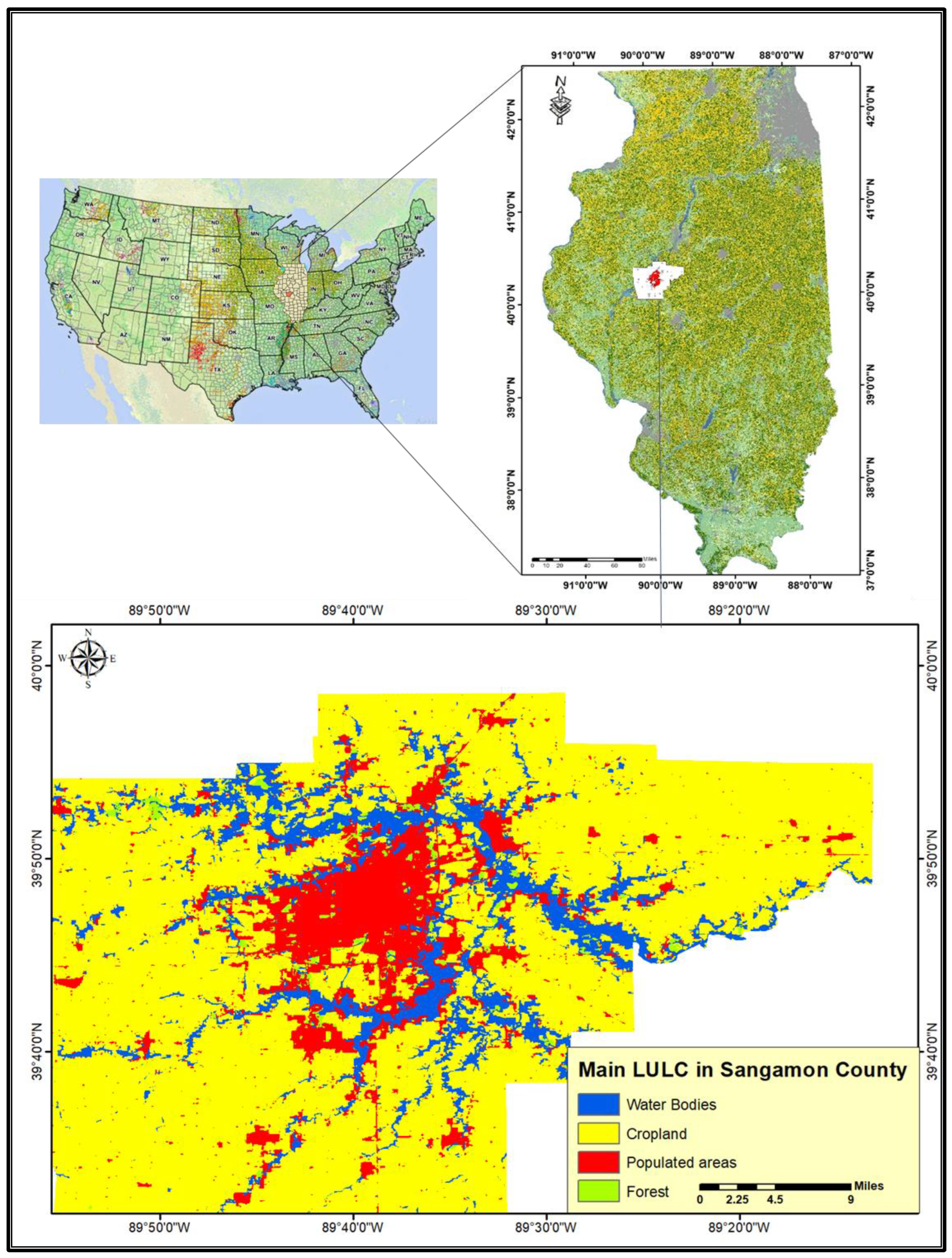


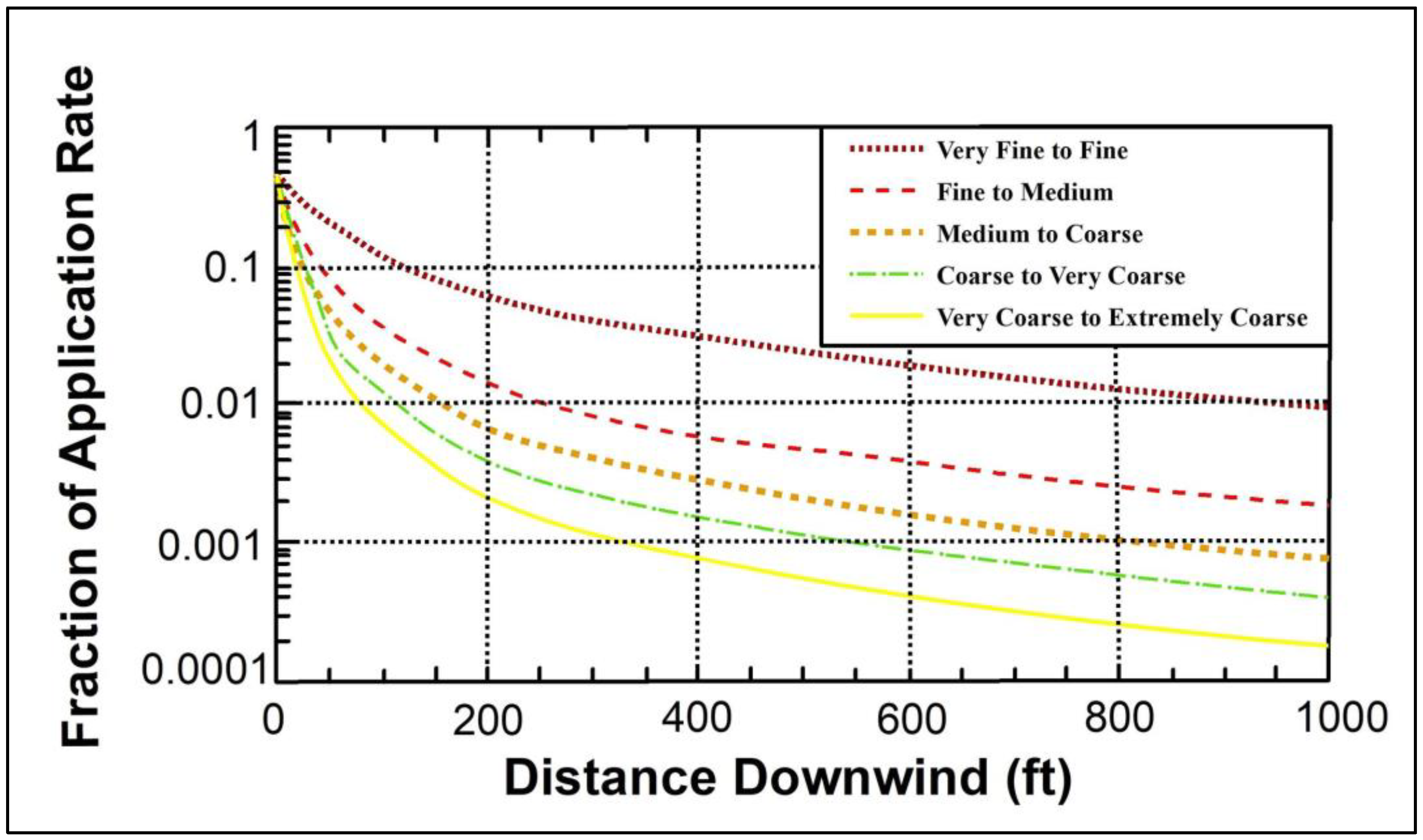
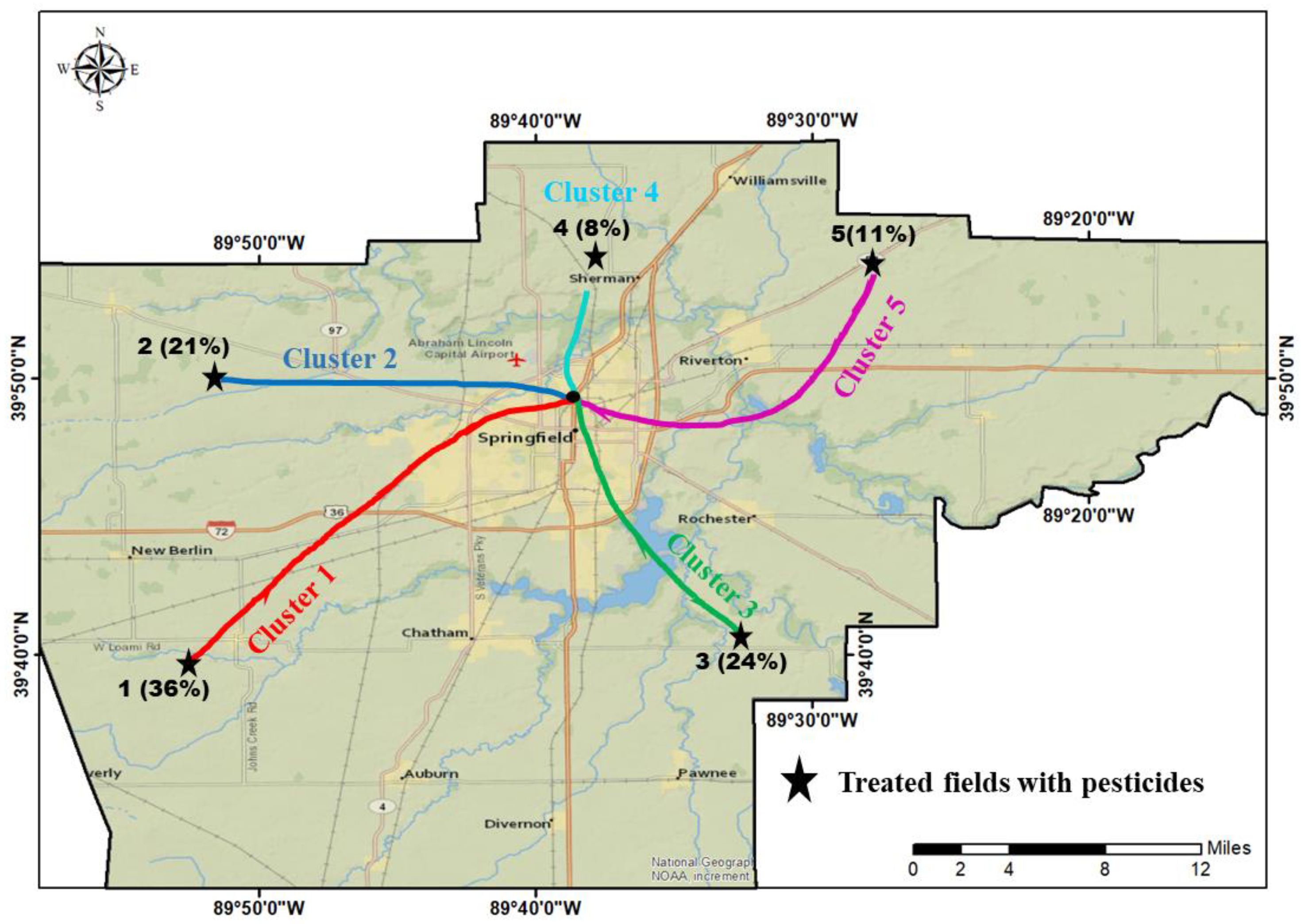



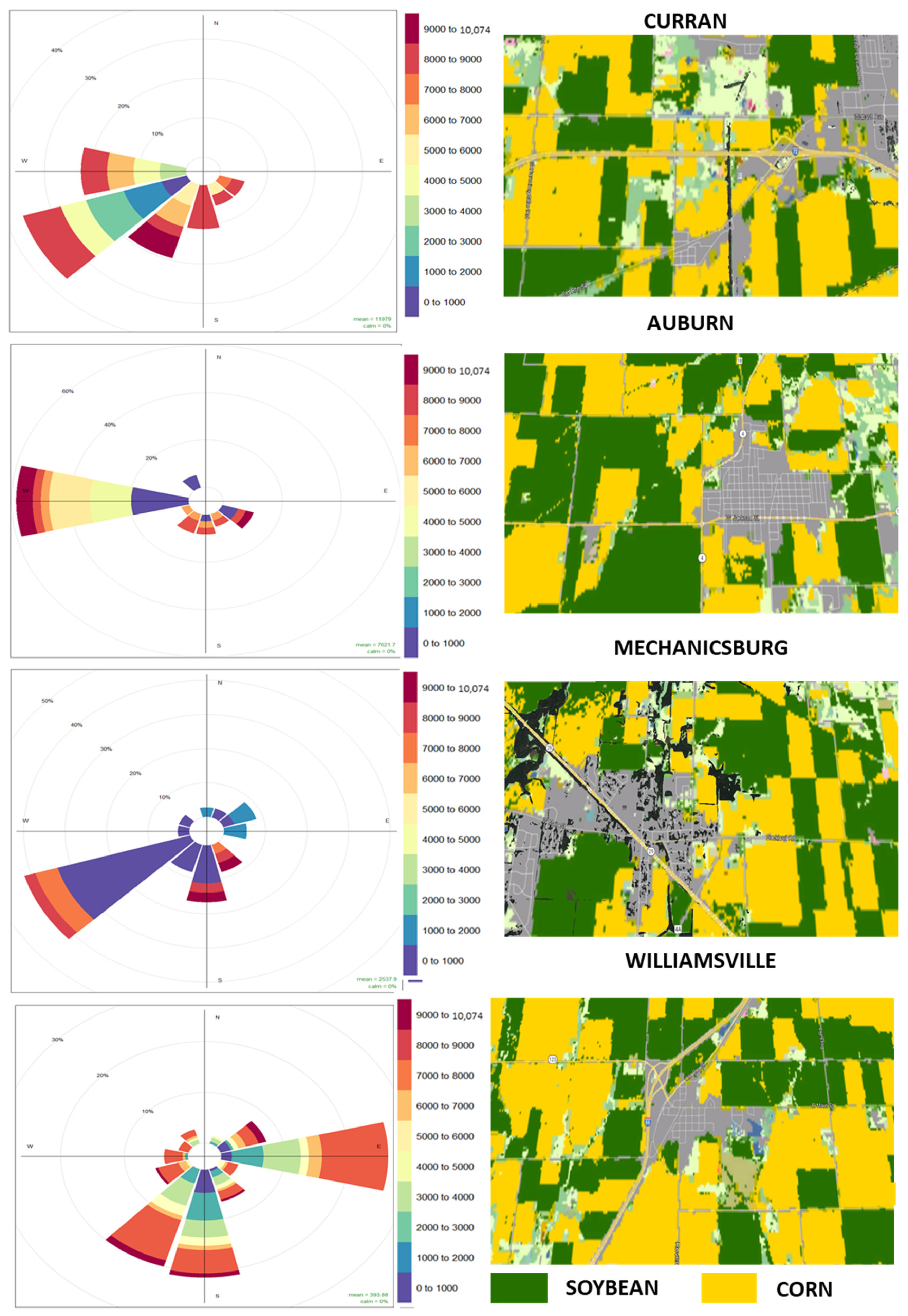
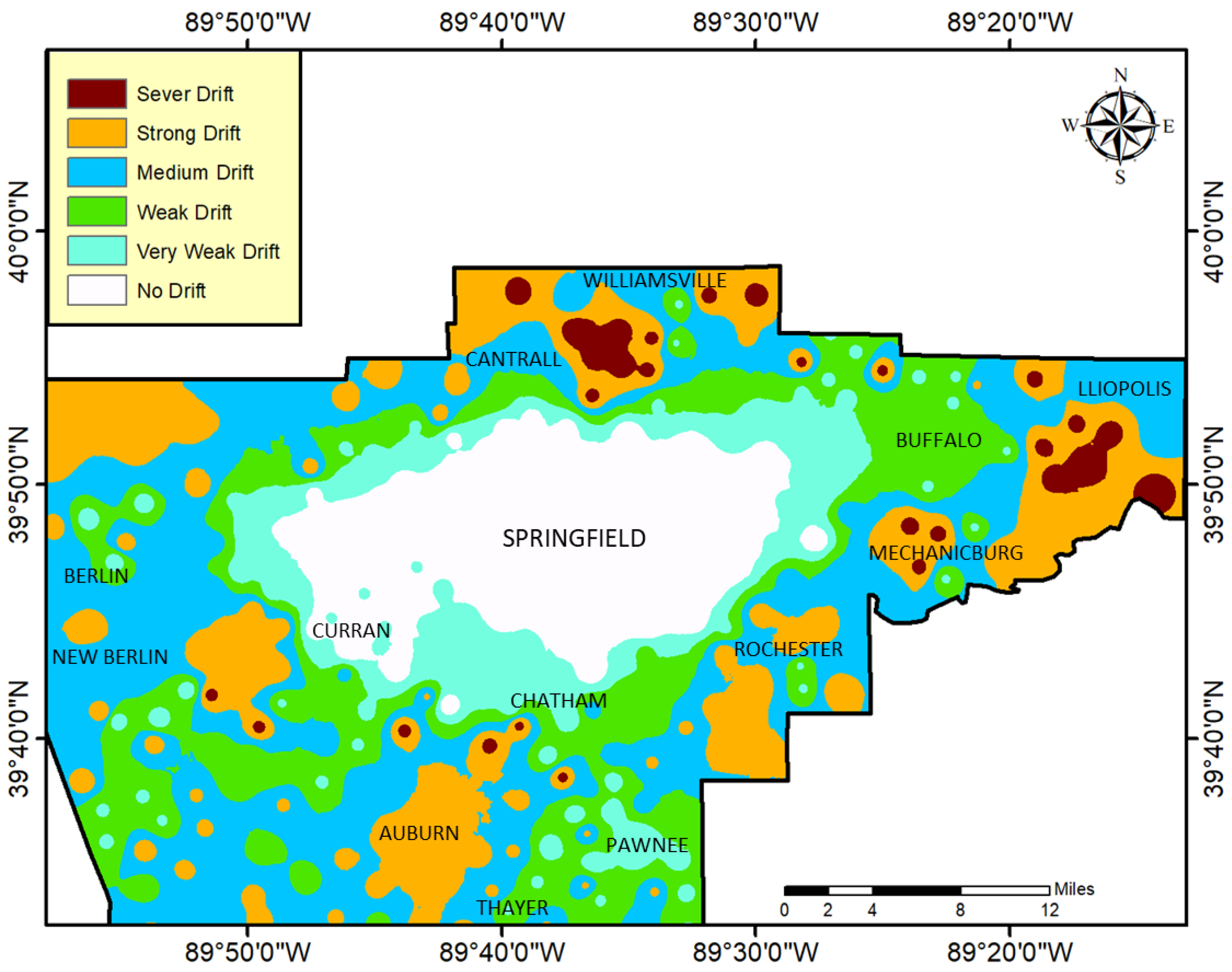

| Components and Description | Illinois | Sangamon | % |
|---|---|---|---|
| Administration region’s area calculated in acres (ATLAS_ACRE) | 35,529.820 | 555,713 | 1.66 |
| Harvested cropland in acres (ACRES_HC) | 22,701.380 | 451,836 | 1.90 |
| Harvested crops in square miles (SQ_MI_HC) | 3504.720 | 75.289 | 2.15 |
| Aggregate weight in kilograms (kg) of the EPest-high estimations for each of the eight organophosphates (AGG_HI_KG) | 2220.993 | 50.531 | 2.4 |
| Total weight in pounds (lbs) of all eight organophosphate pesticides based on EPest-high estimations (HI_LB_AGG) | 491.616 | 12.193 | 2.5 |
| EPest-high estimations of organophosphate pesticide usage throughout harvested crops (HI_LOG_RAT) | 757.537 | 120.940 | 1.5 |
| EPest-high estimations of organophosphate concentration in pounds per square mile | 1085.900 | 16.195 | 1.47 |
| Organophosphate Pesticide | Use in Kilograms |
|---|---|
| Bensulid | 27.80 |
| Chloreth | 91.50 |
| Chlorpyr | 335.6 |
| Dimethoa | 62.00 |
| Malathion | 197.70 |
| Phosmet | 21.80 |
| Terbufos | 1790.80 |
| Tribufos | 27.50 |
| Total | 2553 |
| Main LULC Unit | Area km2 | % |
|---|---|---|
| Cropland | 17.396 | 76.72 |
| Populated areas | 2.582 | 11.38 |
| Water bodies | 2.340 | 10.32 |
| Forest | 358 | 1.58 |
| Total | 22,677 | 100 |
| Pesticide Characteristics | Standard Quantities |
|---|---|
| Initiate time of the simulation | 12:00–14:00 |
| Average time spent | 120 min |
| Average area of application | 148,320 m2 |
| The average amount of pesticides released | 6 kg |
| Average quantity of the chemical ingredient employed | 0.4 kg |
| Average application heights | 10–20 feet |
| Active substance | Malathion |
| Particle’s mean diameter | 50 μm |
| Half-life in ground | 17 days |
| Half-life (utilizing O3 and OH) | 14 h to 9 days |
| Hourly simulation-based mean emission rate (EMAH) | 0.029/h and 23.9 h |
| Diffusivity (malathion) | 0.0569 cm2/s |
| Solubility (malathion) | 145 mg/L at 20 °C |
| Pressure of vapor (malathion) | 1.77 × 4–10 mm/Hg at 26 °C |
| Constant of Henry’s law (malathion) | 2.0 (±1.2) × 10–7 |
| Parameter | Very Fine to Fine | Fine to Medium | Medium to Coarse | Coarse to Very Coarse |
|---|---|---|---|---|
| Swath Displacement/Swath | 0.6506 | 0.3722 | 0.2851 | 0.2191 |
| D v0.1 | 62 μm | 114 μm | 157 μm | 209 μm |
| VMD (Dv0.5) | 137 μm | 255 μm | 341 μm | 439 μm |
| D v0.9 | 237 μm | 444 μm | 560 μm | 786 μm |
| Fraction < 141 μm | 0.52 | 0.16 | 0.08 | 0.05 |
| The Crops | High Sprayer Boom/Fine Droplet 137 μm | Low Sprayer Boom/Fine Droplet 255 μm | High Sprayer Boom/Coarse Droplet 341 μm | Low Sprayer Boom/Coarse Droplet 439 μm |
|---|---|---|---|---|
| Drift range estimation for ground boom application | ||||
| Soybean | 350 | 200 | 100 | 50 |
| Corn | 350 | 200 | 100 | 75 |
| Drift range estimation for aerial application | ||||
| Soybean | 750 | 600 | 500 | 250 |
| Corn | 800 | 600 | 500 | 250 |
| Highly Valuable Resources | Acres | The Average of the Potential Spray Drift for All Possible Directions in the Curran Field | Average Drift | |||||||
|---|---|---|---|---|---|---|---|---|---|---|
| E | NE | N | SE | S | SW | W | NW | |||
| Residences | 114.5 | 0.00 | 0.00 | 0.00 | 0.00 | 2.20 | 5.30 | 3.50 | 0.00 | 1.38 |
| Rivers, lakes, and streams | 1.300 | 0.00 | 0.00 | 0.00 | 0.00 | 2.20 | 5.30 | 2.85 | 0.00 | 1.40 |
| Auburn field | ||||||||||
| Residences | 266.60 | 0.00 | 0.00 | 0.00 | 2.40 | 2.70 | 0.00 | 5.35 | 0.00 | 1.25 |
| Rivers, lakes, and streams | 1.800 | 0.00 | 0.00 | 0.00 | 2.20 | 2.70 | 0.00 | 4.90 | 0.00 | 1.32 |
| Mechanicsburg field | ||||||||||
| Residences | 123.00 | 0.00 | 0.00 | 0.00 | 1.90 | 3.00 | 4.40 | 0.00 | 0.00 | 1.30 |
| Rivers, lakes, and streams | 960.00 | 0.00 | 0.00 | 0.00 | 1.90 | 3.00 | 3.90 | 0.00 | 0.00 | 1.28 |
| Williamsville field | ||||||||||
| Residences | 150 | 0.00 | 0.00 | 0.00 | 4.40 | 4.90 | 4.70 | 0.00 | 0.00 | 1.75 |
| Rivers, lakes, and streams | 2050 | 0.00 | 0.00 | 0.00 | 4.10 | 4.80 | 4.70 | 0.00 | 0.00 | 1.78 |
| Ground-Boom Application | Downwind Drift Range Parameters (m) | Drift Rate Scenario | |||
| 25 | 50 | 75 | 100 | ||
| Swath-width m/number | 12/3 | 12/5 | 12/7 | 12/9 | Drifting of medium droplets |
| Downwind drift | 4.4 | 3.2 | 1.1 | 0.6 | |
| Drift rate (%) | 19 | 10 | 7.6 | 4.2 | |
| Drift area (km2) | 0.18 | 0.08 | 0.04 | 0.014 | |
| Aerial Application | Downwind Drift Range Parameters (m) | Drift Rate Scenario | |||
| 50 | 100 | 150 | 300 | ||
| Swath-width m/number | 12/4 | 12/8 | 12/12 | 12/16 | Drifting of medium droplets |
| Downwind drift | 7.4 | 6.0 | 4.3 | 1.6 | |
| Drift rate (%) | 40.5 | 36.2 | 26.5 | 20.4 | |
| Drift area (km2) | 0.48 | 0.45 | 0.35 | 0.25 | |
| Curran Field | |||||||||
|---|---|---|---|---|---|---|---|---|---|
| The Crops | Application Technique | Treated Field (ha) | Dominant Wind Direction | Pesticide Rate (kg/ha) | Drift Fraction Fd | Deposition Ratio (ha) | Swath Range (m) | Drift Weight (kg) | Average Differing (%) |
| Soybean | Ground-boom | 42.0 | NE | 2.30 | 0.222 | 3.50 | 1–8 | 1.2 | 4.50 |
| Aerial | 47.0 | W/NW | 2.60 | 0.350 | 5.20 | 1–20 | 2.6 | 8.30 | |
| Corn | Ground | 30.0 | NW | 2.30 | 0.222 | 3.82 | 1–8 | 0.8 | 4.20 |
| Aerial | 42.0 | E/NW | 2.60 | 0.350 | 5.40 | 1–20 | 2.6 | 7.60 | |
| Auburn field | |||||||||
| Soybean | Ground | 36.50 | SE | 2.30 | 0.222 | 3.61 | 1–8 | 0.9 | 5.50 |
| Aerial | 46.60 | S/SW | 2.60 | 0.350 | 4.80 | 1–20 | 2.5 | 8.20 | |
| Corn | Ground | 36.50 | SE | 2.30 | 0.222 | 2.82 | 1–8 | 0.9 | 4.50 |
| Aerial | 46.60 | S/SW | 2.60 | 0.350 | 5.60 | 1–20 | 2.5 | 7.90 | |
| Mechanicsburg field | |||||||||
| Soybean | Ground | 26.8 | NE | 2.30 | 0.222 | 3.61 | 1–8 | 0.7 | 5.90 |
| Aerial | 34.2 | N | 2.60 | 0.350 | 4.80 | 1–20 | 2.2 | 9.50 | |
| Corn | Ground | 26.8 | NE | 2.30 | 0.222 | 2.82 | 1–8 | 0.7 | 6.90 |
| Aerial | 36.5 | N | 2.60 | 0.350 | 5.60 | 1–20 | 2.2 | 9.50 | |
| Williamsville field | |||||||||
| Soybean | Ground | 24.6 | SE | 2.30 | 0.222 | 3.61 | 1–8 | 0.9 | 4.50 |
| Aerial | 38.6 | SW | 2.60 | 0.350 | 4.80 | 1–20 | 2.4 | 8.50 | |
| Corn | Ground | 24.6 | SE | 2.30 | 0.222 | 2.82 | 1–8 | 0.9 | 4.50 |
| Aerial | 38.6 | SW | 2.60 | 0.350 | 5.60 | 1–20 | 2.4 | 8.50 | |
Disclaimer/Publisher’s Note: The statements, opinions and data contained in all publications are solely those of the individual author(s) and contributor(s) and not of MDPI and/or the editor(s). MDPI and/or the editor(s) disclaim responsibility for any injury to people or property resulting from any ideas, methods, instructions or products referred to in the content. |
© 2024 by the authors. Licensee MDPI, Basel, Switzerland. This article is an open access article distributed under the terms and conditions of the Creative Commons Attribution (CC BY) license (https://creativecommons.org/licenses/by/4.0/).
Share and Cite
El Afandi, G.; Ismael, H.; Fall, S. A Hybrid Modeling Approach for Estimating the Exposure to Organophosphate Pesticide Drift in Sangamon County, Illinois. Sustainability 2024, 16, 2908. https://doi.org/10.3390/su16072908
El Afandi G, Ismael H, Fall S. A Hybrid Modeling Approach for Estimating the Exposure to Organophosphate Pesticide Drift in Sangamon County, Illinois. Sustainability. 2024; 16(7):2908. https://doi.org/10.3390/su16072908
Chicago/Turabian StyleEl Afandi, Gamal, Hossam Ismael, and Souleymane Fall. 2024. "A Hybrid Modeling Approach for Estimating the Exposure to Organophosphate Pesticide Drift in Sangamon County, Illinois" Sustainability 16, no. 7: 2908. https://doi.org/10.3390/su16072908
APA StyleEl Afandi, G., Ismael, H., & Fall, S. (2024). A Hybrid Modeling Approach for Estimating the Exposure to Organophosphate Pesticide Drift in Sangamon County, Illinois. Sustainability, 16(7), 2908. https://doi.org/10.3390/su16072908









